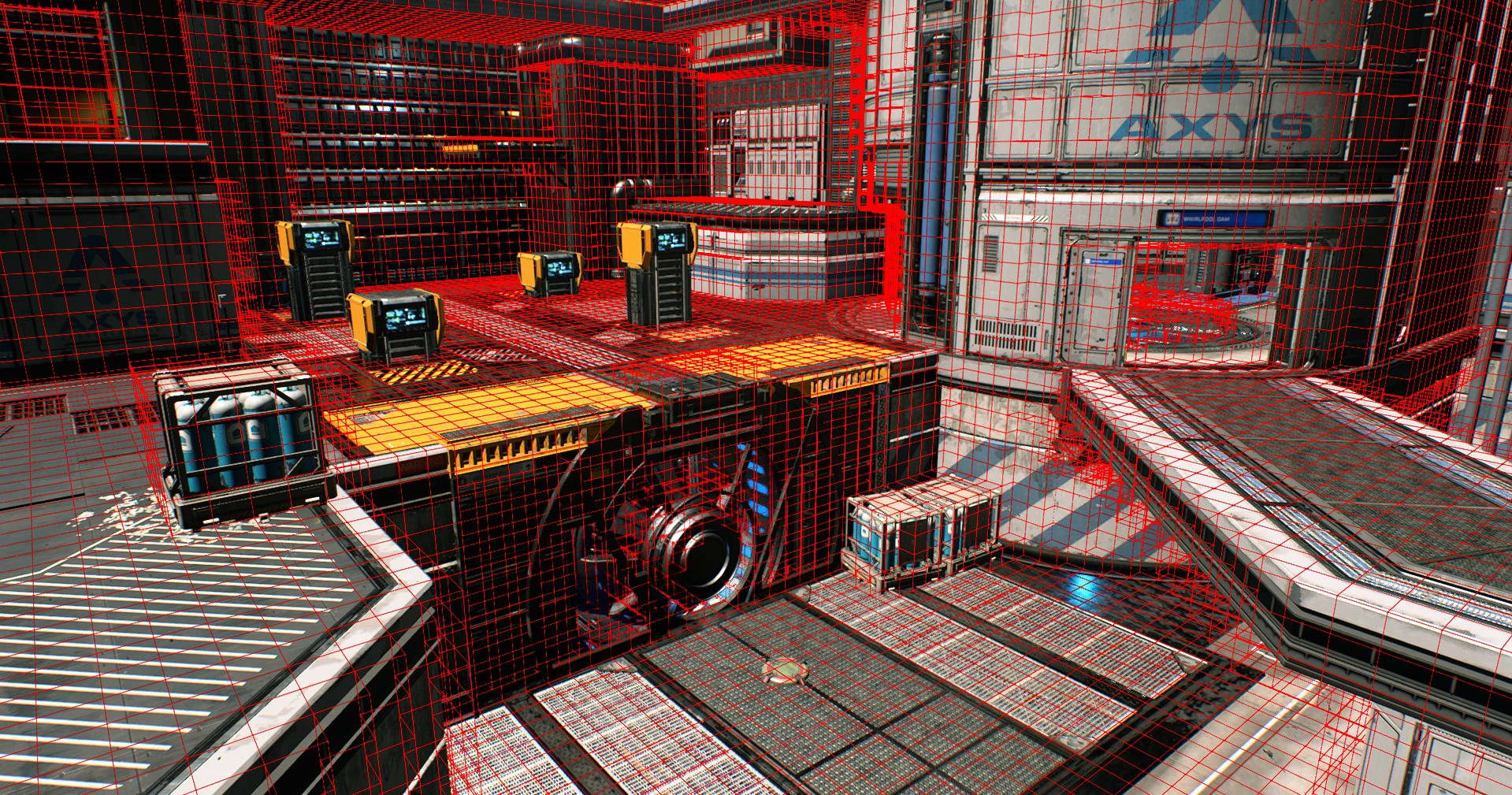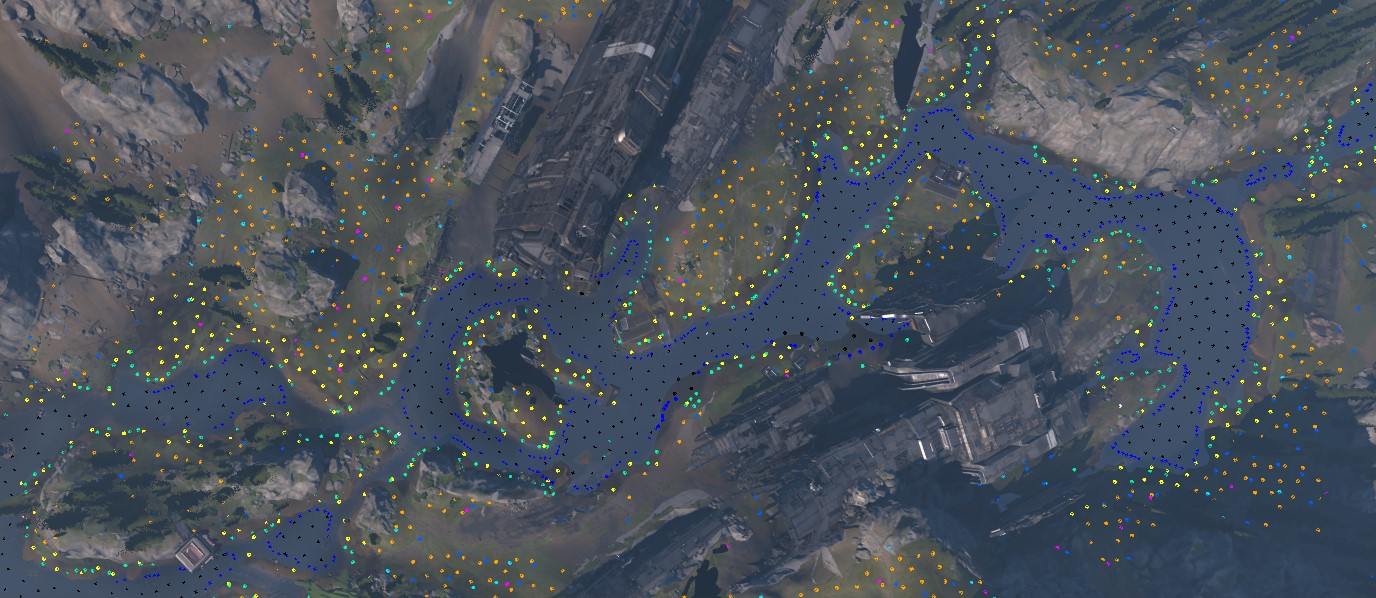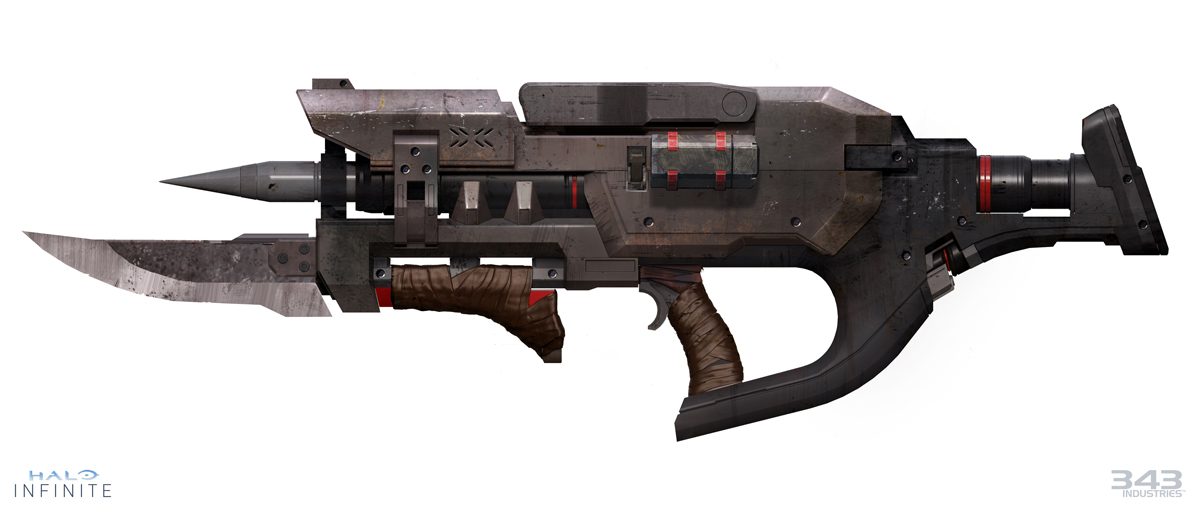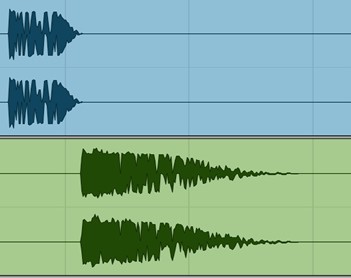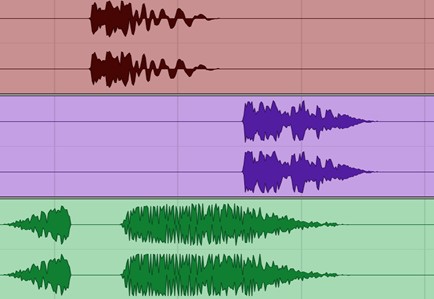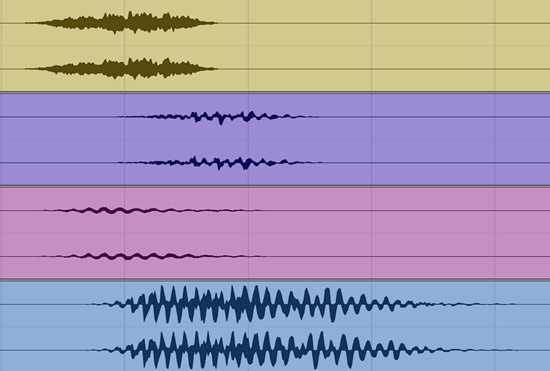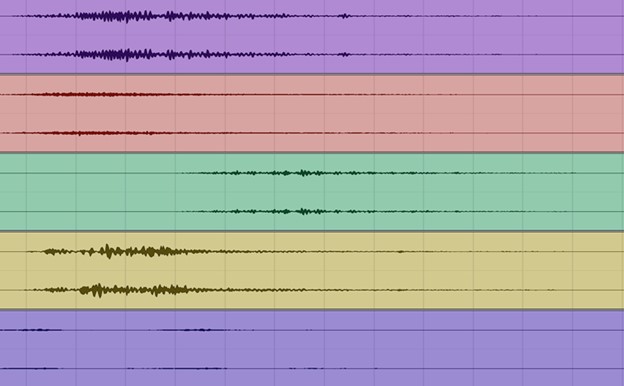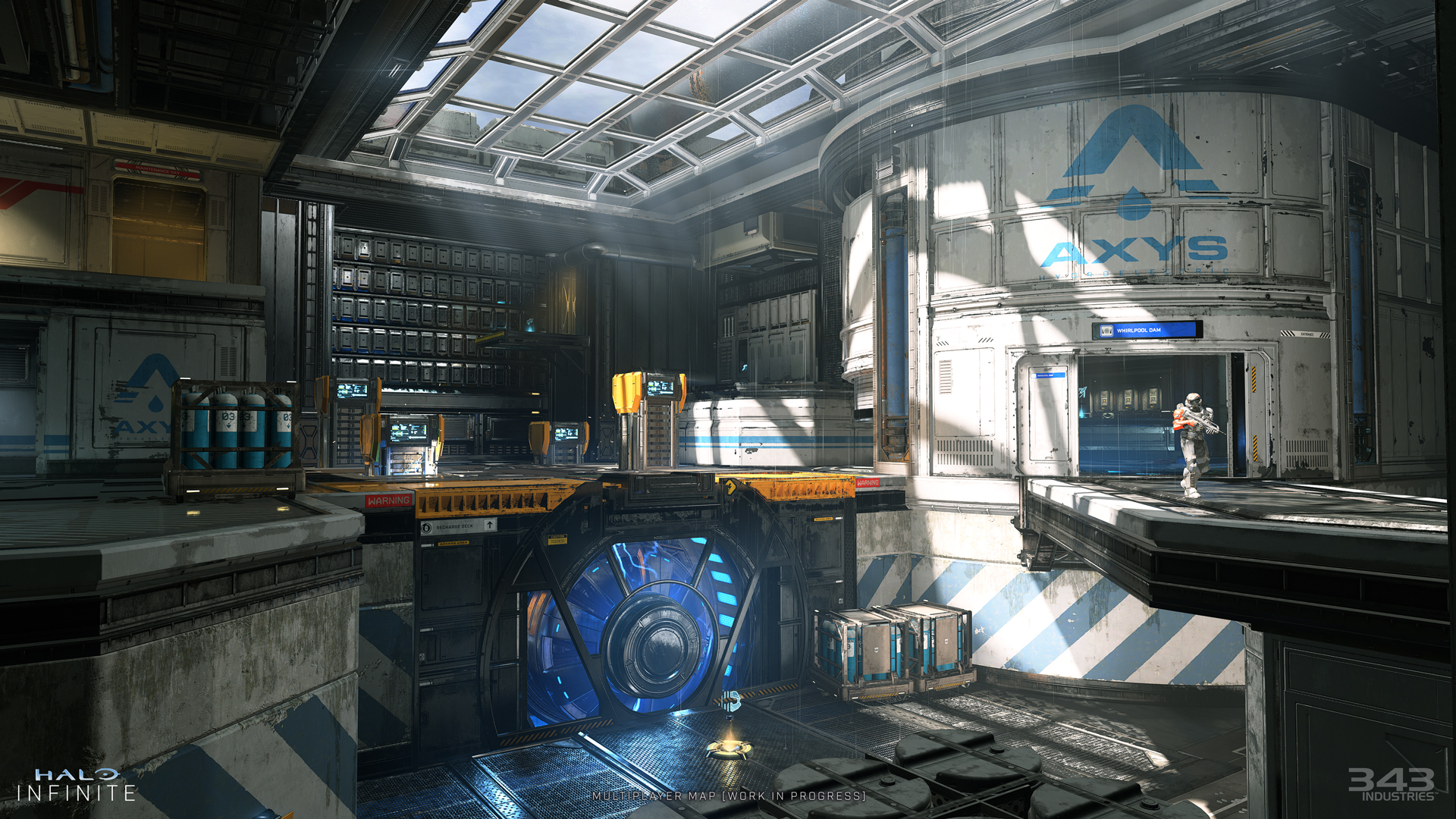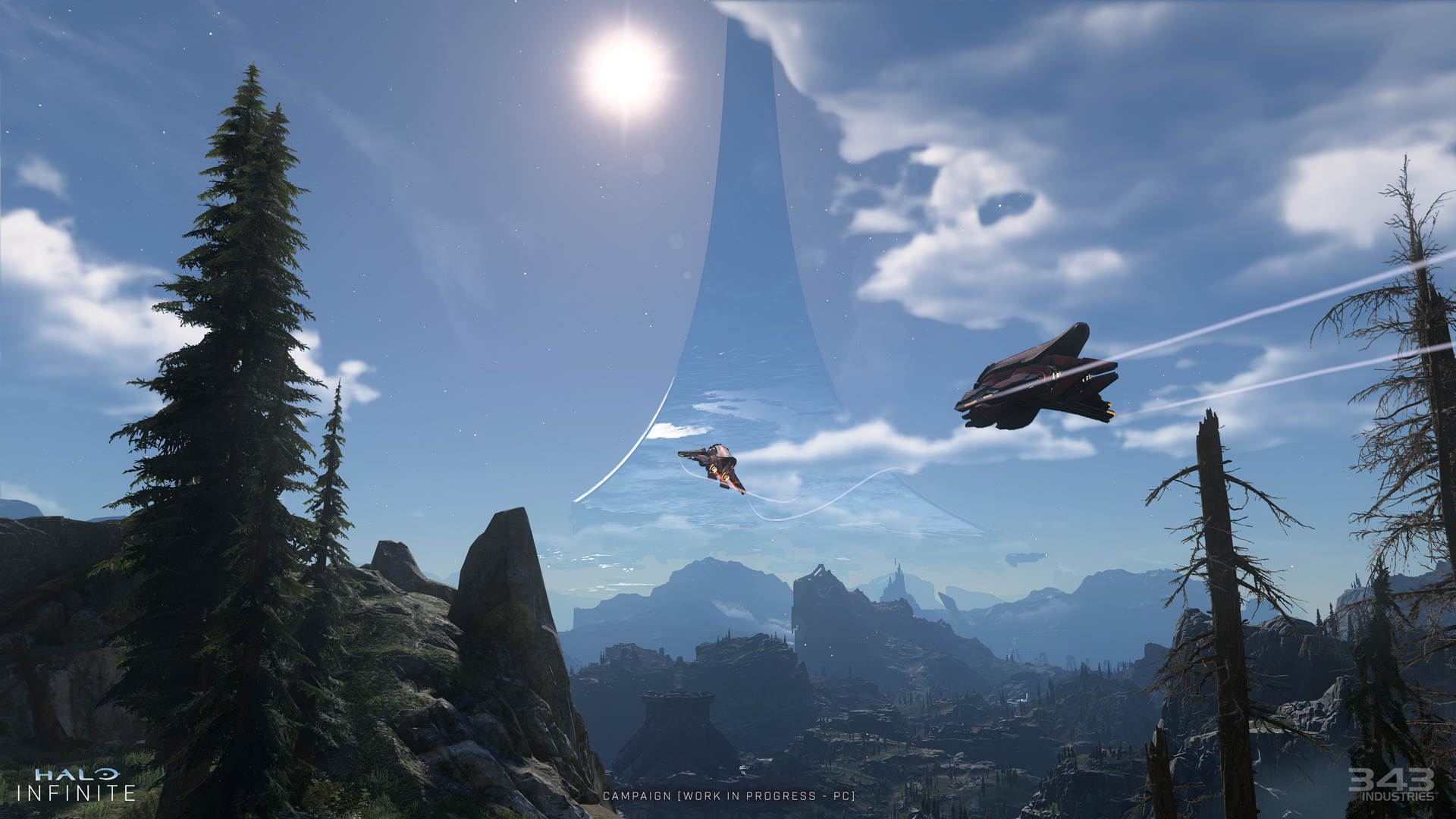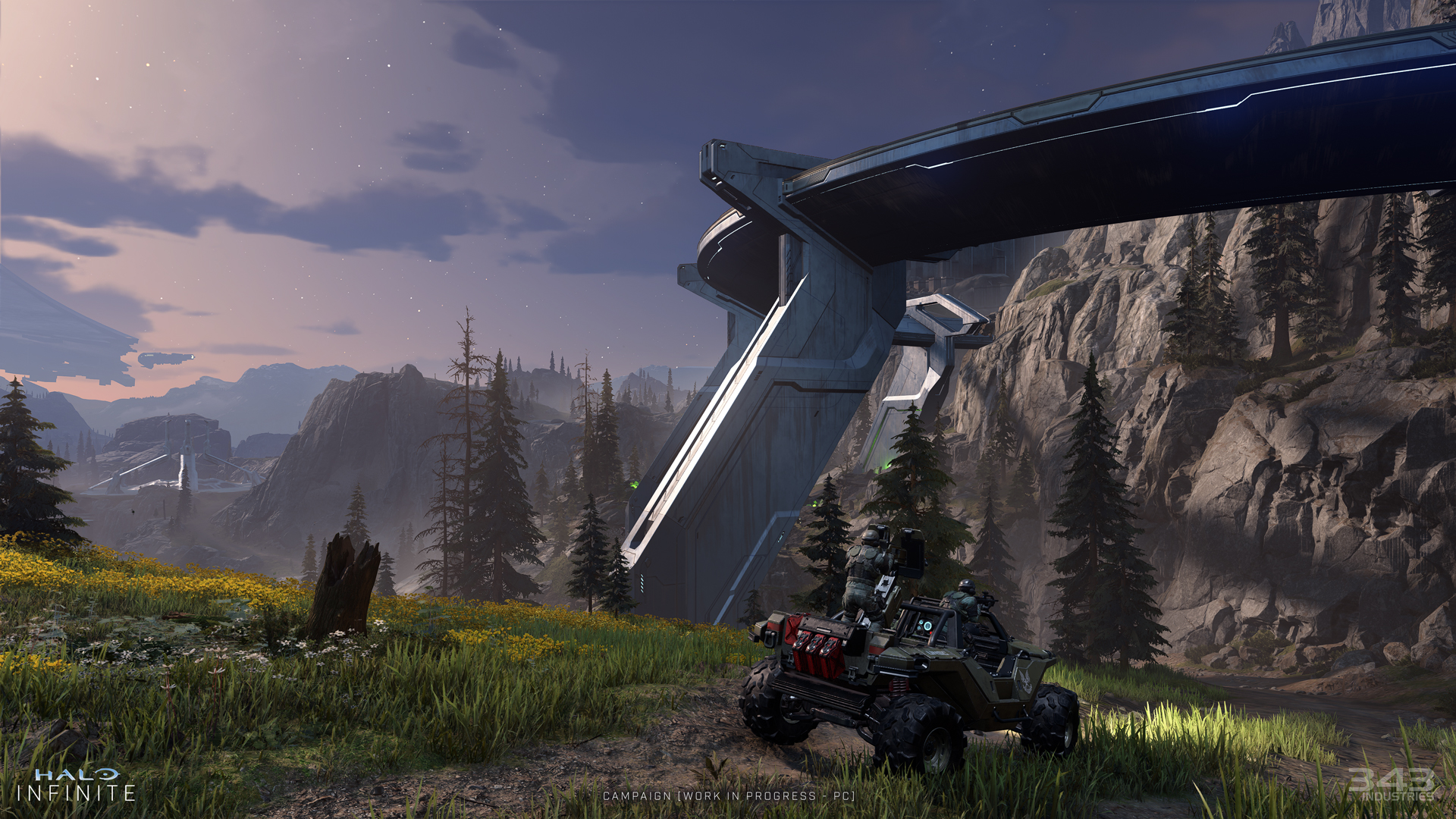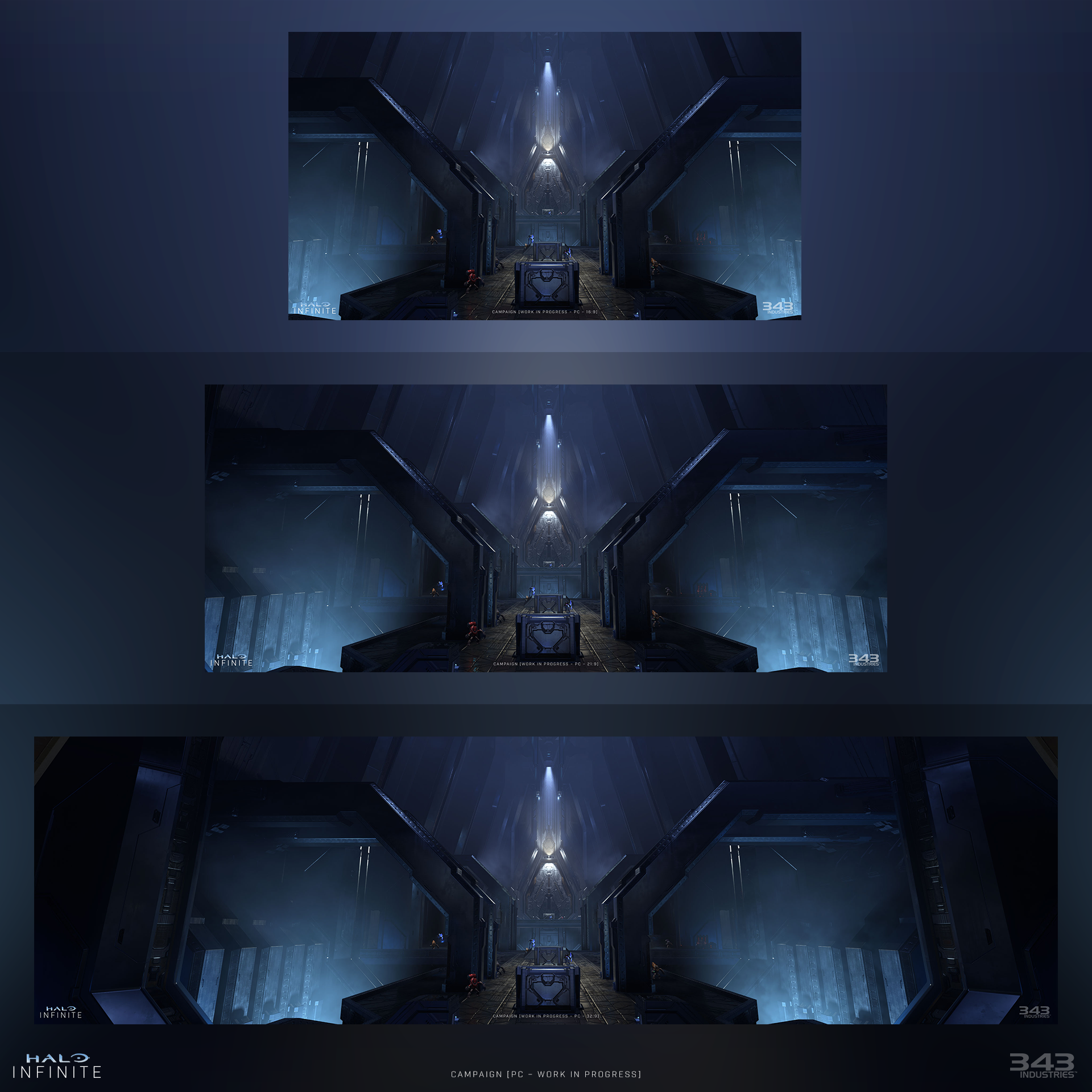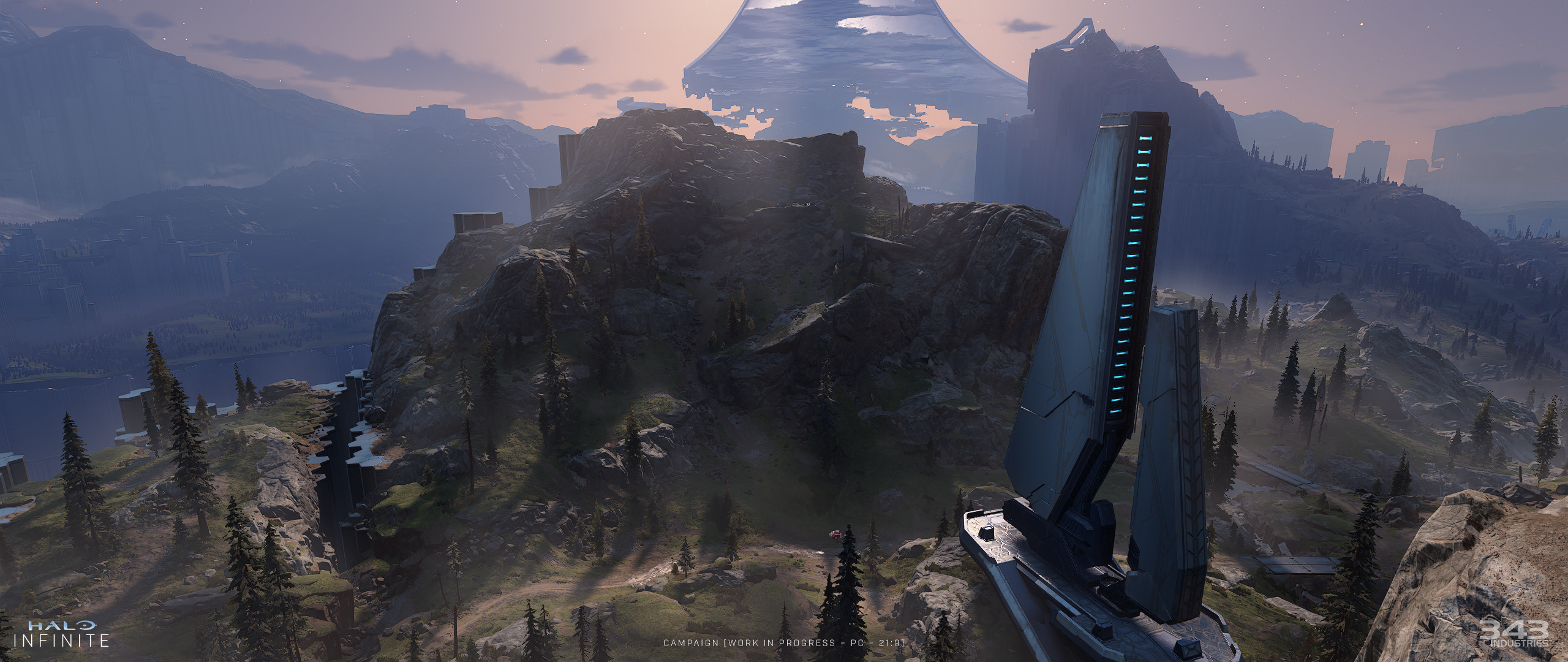Even though we knew it would be a tremendous amount of work, we decided to re-establish sound contents and systems almost from scratch as our first priority from the very start of Halo Infinite development. It was a tough and long load, but I’m incredibly proud of the amazing work across my team to help us realize our new vision. Audio Devs, Audio Technical Designers, Sound Designers and even our Music Team all worked together bringing ideas from each team’s perspective to hit the one single goal which is cleaner and more impactful audio.
Let me share one example to explain how our team tried to achieve that. There are many gun sounds in our game - multiple enemies, teammates, and players are constantly firing weapons. In our past Halo titles, we handled each gun-fire’s listening-volume purely by distance. So, all gun sound volumes were exactly the same if they’re originating from the same distance. As a result, we had too many loud gun sounds constantly overwhelming a player which made it very difficult to detect true threat position.
The new Halo Infinite audio system detects all gun sounds frame by frame, and prioritizes them in a threat order to decide output sound volume for each gun. With this mechanic, if a gunshot is aimed at player, the sound will be louder and if it’s not aimed at player or if it’s a teammate’s gunfire, the sound is still audible but quieter. then you could hear only threat sounds clear. With the cleaner audio feedback, player can ascertain the appropriate threat to make the right action quicker and more accurately, which results in a more immersive and exciting combat experience in Halo Infinite.
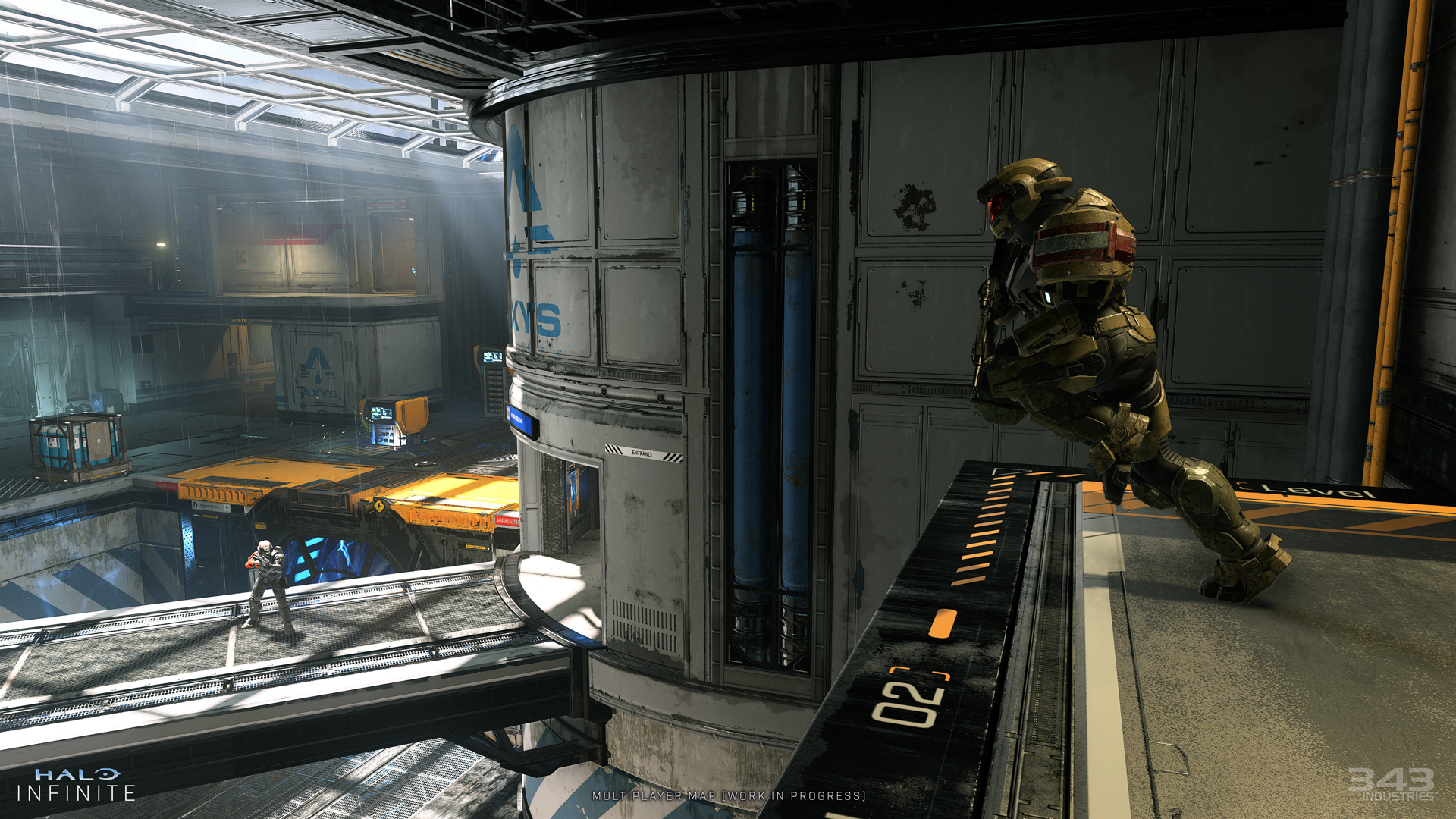
Can you talk about your content design approach for the sounds we’ll hear in Halo Infinite?
KF: For Infinite we really changed our approach for how we went about authoring our content. The main thing it revolved around is keeping the mix in mind.
In previous games our assets were relatively longer, incredibly compressed, and over saturated. This, in turn, would cause other sounds to compete with each other and lead to a very fatiguing experience over time. The solution to this is to be strict about the overall dynamics with keeping the assets short and compact. Previously, assets would have a long decay time which would be at the same amplitude as the initial start of the sound, that would carry on for too long. Which would look like this…

In the picture above, you can see the asset stays at the peak for too long.
For Infinite, we now author the content to have shorter duration at which it is at its peak loudness, which would look more like this…
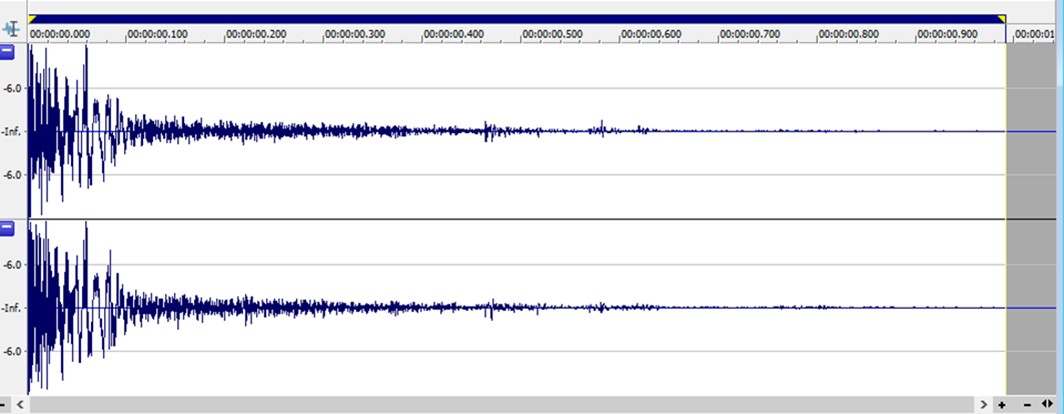
As you can see in the figure above, the new approach has a dramatically shorter time in which it stays at its peak amplitude, it has a sharp attack and begins to decay quickly. This creates a greater sense of dynamics and helps carve out some space in the overall mix.
Here goes another comparison of a Halo 5 BR (top image) and Infinite BR (bottom image) as heard from the 3rd person perspective (click on each image to listen to the audio):
Impacts are much shorter, which helps in being able to hear the distinct 3 shots clearly, we also have more space in between shots which helps clean things up.
By not designing every sound to be over the top it allows us to create bigger moments and have a more impactful experience for the things that should be loud and in your face.
Along with having a better sense of dynamic range in our content, as Tajeen mentioned we are also very careful about the amount of detail we use in any given sound. As a designer your first instinct is to want to make everything as shiny and epic as possible, which is great if it’s played in isolation, but when heard with 50-100+ sounds playing at the same time it will completely compromise the overall mix of the game. This really forced the mentality that it is not about the individual parts but how it all comes together as a whole. Through these approaches I really feel that our game has a great sense of clarity, more depth to the sound field, and allows you to take in the most important audio feedback.
And from a systems perspective, how do you achieve your goals of making combat more immersive for our players?
CT: We are so excited for players to experience the new audio systems and technologies we’ve developed for Halo Infinite! We’ve spent the past several years developing new systems across the entire game, many of them with the explicit goal of supporting Tajeen’s direction to prioritize clear, impactful, and satisfying combat sounds. This has helped create a more immersive combat experience by really maximizing the impact of the most important sounds.
One of the most exciting is our custom-built Acoustic Simulation system, developed exclusively for Halo Infinite. This was one of the first new systems we worked on for this game, and certainly the one we’ve spent the most development time perfecting, tuning, and optimizing. This system simulates the way sound travels through the environment, reflecting off the walls and filtering through doors and windows.
Our acoustic system uses concepts like obstruction, occlusion, propagation, and reverberation to make sounds really feel like they’re in that space. Whether in the next room over, behind a large boulder, or somewhere else altogether, this system uses a hybrid of voxelization with room-and-portal pathfinding to create a more immersive, natural soundscape.
In a room-and-portal system, sounds travel from room to room through doorways, windows, and other “portals”. These paths are used to determine the shortest distance the sound could travel to get from the room the sound is playing from to the room where the listener is located. We then calculate the angles and distances of the path segments, and use that to determine how much to filter (i.e. muffle) the sound. Lastly, we project the sound out along the path between the listener and the closest portal to create a “virtual position” to simulate sound propagation. This “virtual source” is where the sound then plays from, so that it sounds like it is coming from the direction of the doorway, rather than directly from the source itself, as you can see from the following diagram:
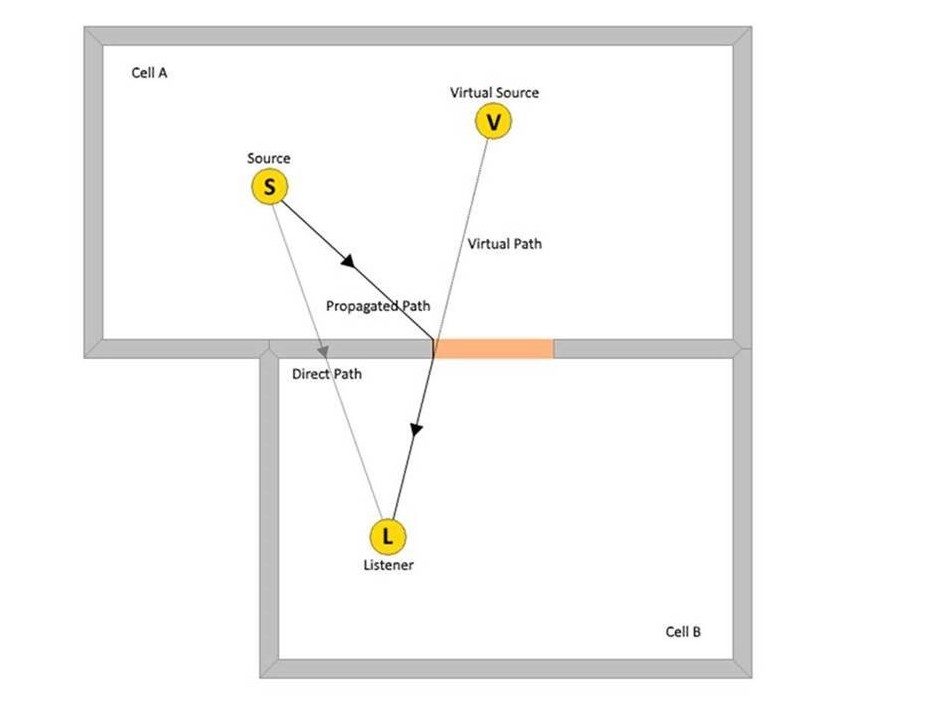
Let me share one example to explain how our team tried to achieve that. There are many gun sounds in our game - multiple enemies, teammates, and players are constantly firing weapons. In our past Halo titles, we handled each gun-fire’s listening-volume purely by distance. So, all gun sound volumes were exactly the same if they’re originating from the same distance. As a result, we had too many loud gun sounds constantly overwhelming a player which made it very difficult to detect true threat position.
The new Halo Infinite audio system detects all gun sounds frame by frame, and prioritizes them in a threat order to decide output sound volume for each gun. With this mechanic, if a gunshot is aimed at player, the sound will be louder and if it’s not aimed at player or if it’s a teammate’s gunfire, the sound is still audible but quieter. then you could hear only threat sounds clear. With the cleaner audio feedback, player can ascertain the appropriate threat to make the right action quicker and more accurately, which results in a more immersive and exciting combat experience in Halo Infinite.

Can you talk about your content design approach for the sounds we’ll hear in Halo Infinite?
KF: For Infinite we really changed our approach for how we went about authoring our content. The main thing it revolved around is keeping the mix in mind.
In previous games our assets were relatively longer, incredibly compressed, and over saturated. This, in turn, would cause other sounds to compete with each other and lead to a very fatiguing experience over time. The solution to this is to be strict about the overall dynamics with keeping the assets short and compact. Previously, assets would have a long decay time which would be at the same amplitude as the initial start of the sound, that would carry on for too long. Which would look like this…

In the picture above, you can see the asset stays at the peak for too long.
For Infinite, we now author the content to have shorter duration at which it is at its peak loudness, which would look more like this…

As you can see in the figure above, the new approach has a dramatically shorter time in which it stays at its peak amplitude, it has a sharp attack and begins to decay quickly. This creates a greater sense of dynamics and helps carve out some space in the overall mix.
Here goes another comparison of a Halo 5 BR (top image) and Infinite BR (bottom image) as heard from the 3rd person perspective (click on each image to listen to the audio):
Impacts are much shorter, which helps in being able to hear the distinct 3 shots clearly, we also have more space in between shots which helps clean things up.
By not designing every sound to be over the top it allows us to create bigger moments and have a more impactful experience for the things that should be loud and in your face.
Along with having a better sense of dynamic range in our content, as Tajeen mentioned we are also very careful about the amount of detail we use in any given sound. As a designer your first instinct is to want to make everything as shiny and epic as possible, which is great if it’s played in isolation, but when heard with 50-100+ sounds playing at the same time it will completely compromise the overall mix of the game. This really forced the mentality that it is not about the individual parts but how it all comes together as a whole. Through these approaches I really feel that our game has a great sense of clarity, more depth to the sound field, and allows you to take in the most important audio feedback.
And from a systems perspective, how do you achieve your goals of making combat more immersive for our players?
CT: We are so excited for players to experience the new audio systems and technologies we’ve developed for Halo Infinite! We’ve spent the past several years developing new systems across the entire game, many of them with the explicit goal of supporting Tajeen’s direction to prioritize clear, impactful, and satisfying combat sounds. This has helped create a more immersive combat experience by really maximizing the impact of the most important sounds.
One of the most exciting is our custom-built Acoustic Simulation system, developed exclusively for Halo Infinite. This was one of the first new systems we worked on for this game, and certainly the one we’ve spent the most development time perfecting, tuning, and optimizing. This system simulates the way sound travels through the environment, reflecting off the walls and filtering through doors and windows.
Our acoustic system uses concepts like obstruction, occlusion, propagation, and reverberation to make sounds really feel like they’re in that space. Whether in the next room over, behind a large boulder, or somewhere else altogether, this system uses a hybrid of voxelization with room-and-portal pathfinding to create a more immersive, natural soundscape.
In a room-and-portal system, sounds travel from room to room through doorways, windows, and other “portals”. These paths are used to determine the shortest distance the sound could travel to get from the room the sound is playing from to the room where the listener is located. We then calculate the angles and distances of the path segments, and use that to determine how much to filter (i.e. muffle) the sound. Lastly, we project the sound out along the path between the listener and the closest portal to create a “virtual position” to simulate sound propagation. This “virtual source” is where the sound then plays from, so that it sounds like it is coming from the direction of the doorway, rather than directly from the source itself, as you can see from the following diagram:

